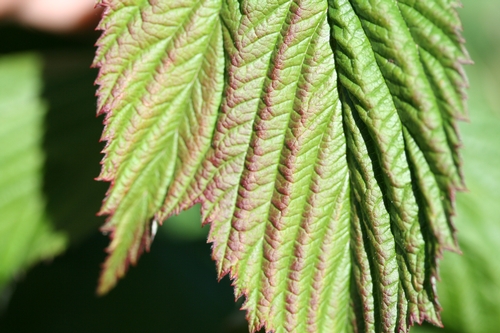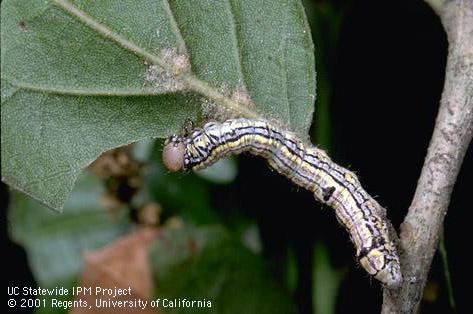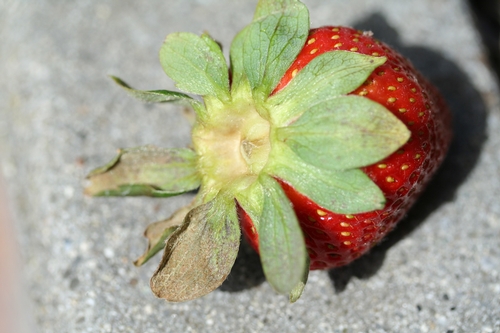Strawberries
Leaf Purpling on Red Raspberry
Here is an interesting case regarding a slight purpling of the newer leaves of raspberry. While the case below involves ‘Polka’ variety red raspberry, I’ve seen it this year on ‘Josephine’ red raspberry in a different field as well.
The question posed is whether this purpling is meaningful from a plant health standpoint. Will this problem get worse and detract from yield and cause problems with next years crop?
For starters, there is are no disease symptoms, for example necrotic spots or goo seeping out out of the leaves or stems, nor are there any signs of disease, such as spores or conidial structures visible.
We should consider also possible side effects of insecticide or fungicide sprays. I do recall once in a trial on the strawberry variety ‘Diamante’ that repeated applications of a strobilurin fungicide such as Pristine or Quadris resulted in a similar pattern of purpling on the leaves. However in this case on ‘Polka’, the PCA in charge of this field confirmed with me that Pristine had been applied after the symptoms appeared, and this is only one application of the material. There was only one other pesticide application previous to this one, and it was more than a month ago.
What about nutrient deficiency? A simple application of what we know from nutrient deficiency books would inform us that the purpling we see here refers to some sort of phosphorous deficiency, but other nutrients can cause this too. Furthermore, those having more than a passing knowledge of the agricultural soils in the Pajaro and Salinas valleys know they are rarely phosphorous deficient, and more often than not actually have an excess of this nutrient.
Which brings us to nitrogen. Nitrogen, while commonly associated with yellowing rather than purpling of leaves, leaches out of the soil easily and as such can be deficient even in the rich soils of the California central coast. As we know, nitrogen deficiencies can be manifested in plants as a reddening or purpling of the leaves stemming from an accumulation of the same carbohydrates resulting from phosphorous deficiency.
The only way we are going to know if the above has any truth to it at all however is to take some leaf samples. The chart below is from a bulk sample consisting of at least twenty leaves, each taken from around the fifth leaf of the plant (note that this is a bit younger than the seventh leaf common for sampling, but the purpling was only found at this stage and younger).
Samples were analyzed by the Soil Control Lab in Watsonville.
|
Nutrient |
Purple leaves |
Green leaves |
|
Total Nitrogen |
2.4% |
2.6% |
|
Total Phosphorous |
0.28% |
0.29% |
|
Total Potassium |
1.3% |
1.1% |
|
Calcium |
1.3% |
1.8% |
|
Magnesium |
0.53% |
0.65% |
|
Total Sulfur |
0.2% |
0.2% |
|
Copper |
6.1ppm |
7.5 ppm |
|
Zinc |
26 ppm |
26 ppm |
|
Iron |
220 ppm |
260 ppm |
|
Manganese |
210 ppm |
190 ppm |
|
Boron |
46 ppm |
60 ppm |
|
Molybdenum |
3.6 ppm |
5.4 ppm |
The chart above shows us that for one there are no dramatic differences between in nutrient concentrations of green leaves compared to those which are purple. On the other hand, concentrations of nitrogen, phosphorous and potassium are trending just a tad low, with perhaps the nitrogen being the most significant especially since the sampled leaves were on the young side.

Foliar purpling of 'Polka' variety red raspberry

Foliar purpling of 'Polka' variety red raspberry
Finding California Oakworm Moth in Local Berry Fields
Just a real quick note here. Got a useful inquiry yesterday regarding the presence of the moth depicted below in a local berry field.
The moth in question is California oakworm, Phyrganidia californica, the larvae of which feed strictly on oaks. It is harmless to berries. It does seem though this year we have an exceptionally large number of them around and you may be finding them flying around the field or resting on plants, especially if your field is next to oaks.
Additionally, the California oakworm larva (depicted in picture # 2 below), although it would be rare to find one in a berry field, looks nothing like light brown apple moth or any other pestiferous larvae we would commonly expect in caneberries or strawberries.

California oakworm adult moths. These are harmless to berries.

California oakworm larva.
Zeal (etoxazole) Registered for Use in Caneberries
Zeal (etoxazole) is now registered for control of phytophagous mites in caneberries. Zeal is a very welcome addition to our limited suite of miticides in caneberries. Link to the label is here:
http://www.cdms.net/LDat/ld7DK007.pdf
Had lunch at the Nickel with Tom Dewitt from Valent to get some clarification on the use of this material. Our conversation was as follows:
Breadth of Control: Zeal controls phytophagous mites in the Tetranychid family very well, so this includes both twospotted spider mites and Lewis mites. It does not kill eriophyid mites such as redberry mite nor tarsonemid mites such as cyclamen mite. As a translaminar material, it doesn't matter that the residue doesn't stick around that long on the leaf surface, since plant feeding mites will still pick it up when they penetrate the leaves to feed. It is important then also to not apply Zeal with surfactants that are stickers because they will impede the translaminar activity and instead to go with a good nonionic surfactant.
Activity on Predatory Mites: Zeal should not be applied on top of a population of predatory P. persimilis mites since it renders the males sterile and the population will cease to grow. It is recommended to hold off on releasing predatory mites until 30 days after an application of Zeal so as not to impede with their activity.
MRL's: Growers and shippers please take note that while Zeal now has a MRL (maximum residue limit) for Canada in strawberries, it does not have an MRL yet in caneberries.
I discuss the use of a miticide in this article. As always, before using this of product, check with your local Agricultural Commissioner's Office and absolutely consult the product label for product registration, restrictions, and use information.
Pruning of 'Natchez' Blackberry
A thread I have been participating on with the North American Raspberry and Blackberry Association (NARBA) email discussion group regards the heavy fruiting of the blackberry variety 'Natchez' and the subsequent repercussions on fruit ripening and to some extent flavor. This is a fairly common problem here on the Central Coast with growers of this variety and I have been asked on several occasions what to do about it.
As one can see from the picture below, the ability of 'Natchez' to produce fruit is tremendous, but unfortunately the leaf area to fruit ratio is rather low here, resulting in the ripening problems mentioned above.
This past week we were fortunate enough to have plant breeder John Clark, who among other blackberry varieties bred 'Natchez', weigh in on managing overcropping of this variety.
He writes that 'Natchez' plants without any lateral shortening, ie pruning of the laterals, overcrop (load up with too much fruit), especially on plants which are fruiting in the first year after planting. He suggests that laterals be shortened to 15-25 inches long (prior to flowering obviously) to limit the crop down to what the plant can ripen with the available leaf surface area and carbohydrate reserves in the plant itself.
Simply put, the key to getting 'Natchez' to ripen and flavor up properly is maintaining an adequate ratio of leaves to fruit by pruning the laterals back to 15-25 inches.

Overcropping of fruit on the blackberry variety 'Natchez'
Case of Calyx Browning Caused by Spider Mites
Interesting case here of calyx browning caused by spider mites. Most strawberry industry people normally will correctly associate calyx browning with a lack of water or plant physiological issues, but this case of calyx browning is clearly being caused by spider mites.
As one can see from the series of pictures below, brown and spotted patches are all associated with mites and webbing.
The grower reports that the rest of the plant is fine and very few leaves are affected anywhere. It does beg the question why the mites would be specifically infesting the fruit calyces only, but control will be the same as for foliar infesting mites.

Overview of browned calyx.

Close up of damaged calyx. Look closely (click on the picture to enlarge it) and you can see the spider mites.

Another damaged area of the calyx, again with spider mites visible.

